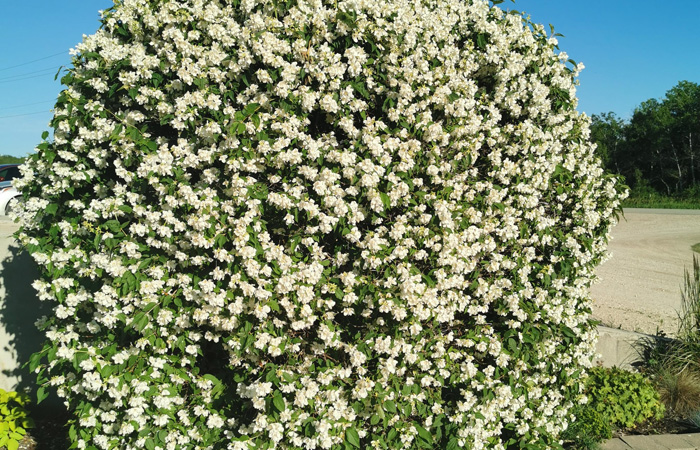Deeply Rooted
Not an Orange – The Blizzard Mockorange

I often find timing is a Mockorange’s greatest asset. As spring arrives Spireas and Lilacs bloom and the flowering crabs put out their brilliant display. There are plants with flamboyant colors like the Deborah Norway Maple, here are large blooms like hydrangeas. These all have strong visual features but when the “Big Spring” show is over and the fall in far away what else is there to see?
One of the features of the Blizzard Mockorange is it’s bloom time. It seems like almost everything else is finished and then comes the Mockorange. Blizzard Mockorange is considered a large shrub similar to standard lilacs approximately 6 to 8 feet tall. I need to point out it’s heavy bloom’s as well. This plant is covered in flowers, and I mean covered! The flowers are two inches across, pure white, and blooms in late June. When planning a yard it is wise to keep a diverse color scheme as well as a diverse show off time. Fall color, summer bloom, and showy fruit display in winter, all of these factor in. A larger shrub does not fit well into foundation planting but it does display well between windows or up against a bare wall. It also works very well as a backdrop plant near the fence.
Another prominent feature of the mockorange is it’s beautiful fragrance, from which it receives its name. The smell is often compared to scent of citrus. l Another feature that makes this plant attractive is it’s drought tolerance. Once established it will do well on a south or west facing wall where it gets a lot of heat and sun. We have found the variety Blizzard to be the most cold tolerant.
The Blizzard Mockorange came out of the Morden research program several years ago. Although Morden research station introduced it, it was discovered as a Seedling in Beaverlodge Alberta. The name blizzard? Well that came out of two significant reasons first of all it is the hardest Mockorange available, tolerant to Zone 2b. The second reason being the profuse number of flowers, making the bush resemble a blizzard when in full bloom.
The final great feature is that it is a heavy nectar producer for hummingbirds and pollinator insects. There isn’t a single plant that has everything going for it, fall color would be a simple yellow in this case. But it more than makes up for its lack of fall luster with its Midsummer blooms. It is also soil adaptable regarding pH and sand or clay, but will not perform well in soggy spots.
In the end it is an excellent shrub and a unique edition for the yard.




